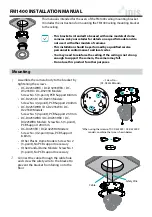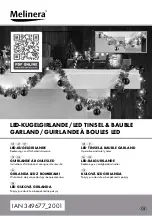
Page 7
HERZ ETKF
Inserting (replacing) batteries
The remote control runs on two LR44 batteries.
•
Remove the battery compartment cover.
•
Insert two new LR44 batteries in the battery compartment (making sure that you insert them the right
way round).
•
Replace the battery compartment cover and latch it into position.
If the remote control is used twice a day, new batteries will have a service life of approximately four years.
A battery symbol (
) on the display indicates that the batteries need to be replaced.
Never recharge standard batteries. Doing so will present a risk of explosion.
Do not throw batteries into a fire.
Do not short-circuit batteries.
Used batteries should not be disposed of with regular domestic waste. Instead, take them to your local
battery disposal point.
Operation
The remote control features an integrated temperature sensor.
Pressing a button briefly will cause the current actual temperature to appear on the display.
Please note that the detected temperature may be affected by body heat. If you hold the remote control in your hand for
a long period or carry it around in a trouser pocket, the temperature measured by the sensor may be very different to the
room’s actual ambient temperature.
As well as displaying the actual temperature, the remote control can also be used to perform two types of operation:
1) Implementing a relative temperature change:
Here, the room’s current set temperature is increased (e.g. +2.5°C) or decreased (e.g. -1.0°C) by the value set on the remote
control.
• The -/+ buttons are used to increase or decrease the temperature in 0.5°C increments.
• Once the buttons have been pressed as many times as required, there is a short delay before the
temperature change is transmitted and the transmission symbol appears on the display.
• The display switches off after 10 seconds of inactivity.
If the display is still active, changing the temperature again will cause only the new temperature difference 17 to be transmit-
ted. If the display has already switched off after 10 seconds of inactivity, the temperature change starts again from 0°C.
2) Comfort temperature/Set-back temperature
The
- buttons are used to activate the comfort/setback temperatures stored in the radio energy-saving controller.
• Pressing the - or
- button activates the corresponding setback or comfort temperature.
• Once the button has been pressed, there is a short delay before the information is transmitted
and the transmission symbol appears on the display.
• The display switches off after 10 seconds of inactivity.
After a short delay, five seconds of transmission starts, during which time the transmission symbol is visible on the display.
If a new operation is performed during these five seconds, the change will not be transmitted until the five seconds have
elapsed.
Teaching-in to radio components
In order to enable communication between radio components, the devices have to be taught-in to one another. The remote
control can be taught-in to system components such as a radio energy-saving controller for radiators.
• First of all, the receiver must be set to teach-in mode. For more information on this, refer to the operating manual for the
relevant device.
• Next, the remote control has to transmit a signal in order to be taught-in. To do this, press one of the buttons two or three
times.
• Please note that the batteries must have already been inserted.
• During transmission, the transmission symbol appears on the display.
A remote control can be taught-in to as many actuators as you wish.
Technical characteristics
Supply voltage:
3 V
Batteries:
2x LR44
Battery life:
4 years approx. (at two operations per day)
Transmission frequency:
868,3 MHz
Range of transmission
in the open air:
30 m
Housing dimensions:
41 x 74 x 15 mm (W x H x D)





























